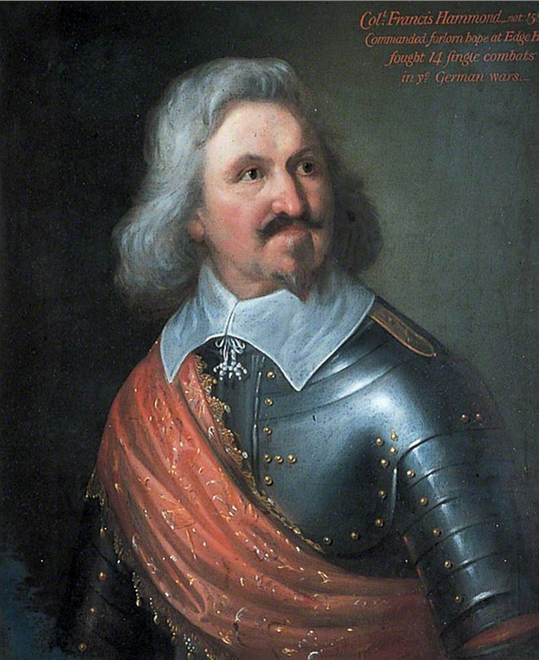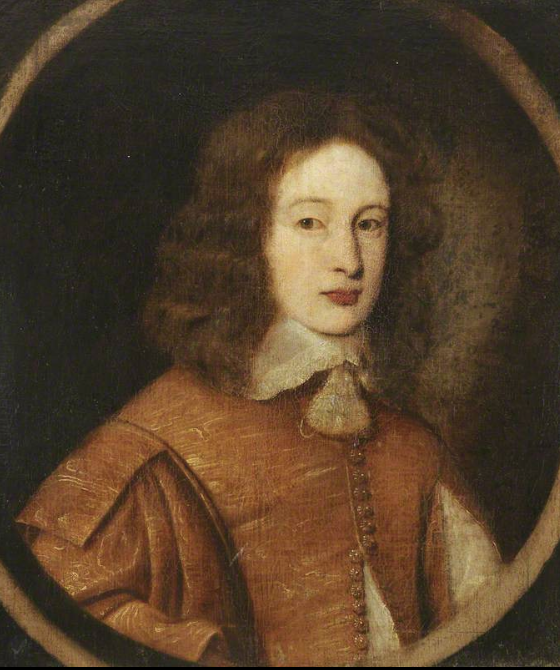March 12, 2015
Painted by an unknown artist, Francis Hammond was a career soldier who had fought on the Continent and even though he was getting on, in the Civil War, noteably leading the royalist Forlorn Hope at Edgehill in 1642. We have already seen his brother, Robert Hammond who was involved in the Kentish Uprising.
He’s clad in what looks like full armour with gilt rivets, though often this was something that was reserved for portraits rather than something you’d wear on the field. His scarf is nicely embroidered and fringed and his falling band, though plain has very fine hems and a nicely knotted bandstring tassel. The portrait is part of the Canterbury Museums Collection.

Posted in Military |
1 Comment »
October 26, 2014
Painted in 1640 by an unknown British artist, Whitgreave fought on the side of the King during the war, ending up being wounded and captured at Naseby. He is better known for his part in the escape of Charles II from the Battle of Worcester, providing shelter for the young king at his home, Moseley Old Hall for two nights during September 1650. Thomas is wearing an odd half doublet, half coat affair with a slit sleeve on his left arm and a heavy, gathered sleeve with a hanging shoulder piece on his right, made of shot silk with intricately woven thread buttons. He also has a laced falling band and some quite complicated tassels on his bandstrings. The picture hangs at the National Trust owned Mosely Old Hall where I guess it has lived since 1640.

Posted in Uncategorized |
Leave a Comment »
May 16, 2014
Senior tutor at Sidney Sussex College Cambridge, painted by an unknown artist in 1653. Matthews is wearing standard academic clothing, black cap, a gown with hanging sleeves over a doublet with linen cuffs and falling band. The work on his doubled cuffs and the intricate band strings are particularly fine. The doublet buttons are enormous!

Posted in Clerical |
Leave a Comment »
February 25, 2014
Painted by a follower of Gilbert Jackson in 1645 four years before his untimely death, Sir Francis was the son of John Acland the Devonian peer who was created first Baronet Acland of Colum John in 1644 by Charles I. The 2nd baronet’s peerage didn’t last long.
Here he is, still very much alive with his dog in an embroidered silk or wool worsted doublet with ribbon decoration at the waist and one of those falling bands that is entirely lace with some nice pom poms on his band strings. That’s Sir Francis in the doublet, not the dog. The picture is kept in the National Trust property Killerton House near Exeter.

Posted in Upper class |
Leave a Comment »
January 9, 2014
Painted by an unknown artist and hanging in the Blake Museum in Bridgwater. I’ve not been able to find out much about William apart from the dates of his birth and death (1635-1707) which date this portrait to 1649.
It’s quite a dark somber picture, but you can see some details here: the tassels on his band strings and the buttons on his doublet, fashionably open to display the linen of his shirt (which is also visible through the slashes on his sleeves). Tricky to spot any more detail, but there may just be a wide band of lace on his falling band and possibly some red-worked embroidery on the lining of his right hand sleeve.

Posted in Children |
Leave a Comment »
November 26, 2013
Picture in the Warrington Museum and Art Gallery painted by an unknown artist. Sir Thomas was a staunch royalist commander and defender of the established Church during the 1640s. The identity of the sitter is not completely certain however, as this chap bears faint resemblance to two other portraits also supposed to be Sir Tom.
Questions of identity apart, here is another example of a 1640s gentleman in his best fashionable black suit. What is particularly fine here is the cutwork lace on his falling band and the cascading tassels on the end of the band strings.

Posted in Upper class |
Leave a Comment »
November 25, 2013
Painted, it is thought by Gilbert Jackson, this portrait came up for auction at Sotherbys and presumably is in private hands. William was Marquis of Hertford and later the second Duke of Somerset. He fought in the West for the royalist cause, at Lansdown and with Rupert in Bristol , later being recalled to Oxford to hold the city in the King’s absence while he was on campaign. He was also foremost in trying to reach agreement between King and Parliament through his brother-in-law the Earl of Essex.
William is pictured in a plain black short tabbed doublet, laced falling band and cuffs. The doublet is cheekily open at the bottom to show a small piece of lace poking out from his shirt.


Here is a detail showing the lace on his band. Notice also the braided decoration on the seams of his doublet.

Posted in Upper class |
Leave a Comment »
September 19, 2013
The Colonel in less warlike dress in a painting in the style of Anthony van Dyck which also hangs in Hardwick Hall in Derbyshire. He is wearing a figured and slashed black doublet showing his white shirt below and an impressive cutwork falling band with decorative pom-pom tassels on his band strings.

Posted in Upper class |
Leave a Comment »
August 13, 2013
This portrait was painted by Gerard Soest sometime during the war. Sir John was Admiral of the Fleet to Charles I which meant that he wasn’t over taxed for the most past of the civil war, because by the time he had returned with the Queen from the Continent, the King had lost most of the navy to Parliament. He did manage to maintain a fleet in the Bristol Channel for a time but that was about the extent of Sir John’s war.
He is pictured in front of a naval engagement in black day cap and back and breastplate over a grey silk doublet. His matching scarf is tied around the waist and patterned with gold threads. He’s also wearing a plain band with a bunch of grapes tassel on the bandstring.
I can’t find the whereabouts of the portrait. it was exhibited in the 1800s but since then has disappeared. I presume it is in private hands.

Posted in Military, Upper class |
Leave a Comment »
May 15, 2013
Painted in or around 1643 this picture has been attributed to Theodore Russell. Catherine was the wife of Lord Brooke the prominent parliamentarian and general who was killed by a royalist sniper whilst directing the siege of Lichfield. This portrait must have been finished after his death as Catherine wears widows weeds and holds a posy of significant flowers. She is wearing a black bodice over a white linen smock with a doubled kerchief which is tied at the throat with bandstrings and a gossamer-thin black linen hood or chaperone on her head. She also wears a white linen coif tied with strings under her chin. Picture courtesy of Roy Precious Antiques and Fine Art. It’s still for sale as as the time of posting.

The posy included pink laurel which was associated with honour, triumph and eternal life. I think there may also be some rosemary here for remembrance. I’m not sure what forms the pinked black edge to the bodice. It looks like a very fine black linen but if it’s part of the bodice it’s tricky to tell. Notice how white and fine her linen is though. This was a wealthy lady.

This close up shows the ties used to keep her coif and kerchief in place. Interestingly you can also see the top of her smock which is much lower than the neck line of her kerchief. Usually both are of about the same height, but in this case the kerchief is tied very high up her throat.

Posted in Upper class, Women |
1 Comment »













